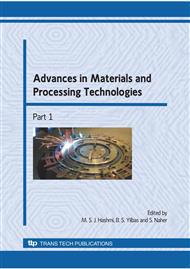p.237
p.244
p.250
p.261
p.269
p.275
p.281
p.289
p.295
Development of Scaffold Building Units and Assembly for Tissue Engineering Using Fused Deposition Modelling
Abstract:
In tissue engineering (TE), a porous scaffold structure of biodegradable material is required as a template to guide the proliferation, growth and development of cells appropriately in three dimensions. The scaffold must meet design requirements of appropriate porosity, pore size and interconnected structure to allow cell proliferation and adhesion. This paper presents a methodology for design and manufacture of TE scaffolds with varying porosity by employing open structure building units and Fused Deposition Modeling (FDM) rapid prototyping technique. A computer modeling approach for constructing and assembly of three-dimensional unit cell structure is presented to provide a solution of scaffolds design that can potentially meet the diverse requirements of TE applications. A parametric set of open polyhedral unit cells is used to assist the user in designing the required micro-architecture of the scaffold with required porosity and pore size and then the Boolean operation is used to create the scaffold of a given CAD model from the designed microstructure. The procedure is verified by fabrication of physical scaffolds using the commercial FDM system.
Info:
Periodical:
Pages:
269-274
Citation:
Online since:
December 2009
Authors:
Price:
Сopyright:
© 2010 Trans Tech Publications Ltd. All Rights Reserved
Share:
Citation:


